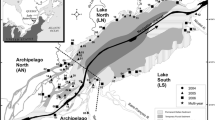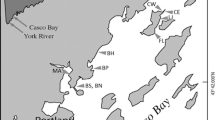Abstract
Seasonal forest ponds (SFPs) are isolated, ephemeral lentic habitats in upland forest ecosystems. These ponds occur commonly throughout temperate forests. Faunal communities of these ponds are dominated by invertebrates. Composition of these communities varies temporally both between years and also seasonally within a single hydrologic year, composition is most affected by pond permanence or hydroperiod. Benthic macroinvertebrates (BMIs) were sampled up to three times a year in five SFPs between 1994 and 1996. The ponds were of short, intermediate, and long hydroperiod. Hydroperiod also varied among years, based on precipitation patterns. During the study, 64,000 specimens of 57 taxa were collected. No pattern was identified in the variation of BMI abundance among years and pond hydroperiod; abundance increased with successive surveys within years. Taxon richness and diversity varied significantly with pond hydroperiod, increasing with increasing hydroperiod. Diversity measures increased over the three years of the study but without obvious pattern across the successive surveys within years. Insects dominated the samples, but large numbers of other Arthropoda and Oligochaeta were also collected. Chironomidae were dominant in most ponds, years, and surveys; chironomid dominance was significantly greater in shorter hydroperiod ponds. Seasonal forest ponds function as aquatic islands in a “sea” of terrestrial forest. The effect of hydroperiod on the composition of the benthic macroinvertebrate community is analogous to that of size on marine island fauna, longer hydroperiod ponds generally have richer invertebrate communities just as larger marine islands typically have richer faunas. However, the effect is confounded by the close relationship between pond hydroperiod and pond size/volume.
Similar content being viewed by others
Literature cited
Bazzanti, M., M. Seminara, and S. Baldoni. 1997. Chironomids (Diptera: Chironomidae) from three temporary ponds of different wet phase duration in central Italy. Journal of Freshwater Ecology 12:89–99.
Blem, C. R. and L. B. Blem. 1991. Cation concentrations and acidity in breeding ponds of the spotted salamander, Ambystoma maculatum (Shaw) (Amphibia: Ambysotmatidae), in Virginia. Brimleyana 17:67–76.
Brooks, R. T., J. Stone, and P. Lyons. 1998. An inventory of seasonal forest ponds on the Quabbin Reservoir watershed, Massachusetts. Northeastern Naturalist 5:219–230.
Calhoun, A. 2000. Best Management Practices (BMPs) for timber harvesting near vernal pools. Unpublished draft report, Maine Department of Inland Fisheries and Wildlife, Bangor, ME, USA.
Collinson, N. H., J. Biggs, A. Corfield, M. J. Hodson, D. Walker, M. Whitfield, and P. J. Williams. 1995. Temporary and permanent ponds: an assessment of the effects of drying out on the conservation value of aquatic macroinvertebrate communities. Biological Conservation 74:125–133.
Cook, R. P. 1983. Effects of acid precipitation on embryonic mortality of Ambystoma salamanders in the Connecticut Valley of Massachusetts. Biological Conservation 27:77–88.
Cowardin, L. M., V. Carter, F. C. Golet, and E. T. LaRoe. 1979. Classification of Wetlands and Deepwater Habitats of the United States. U. S. Fish and Wildlife Service, Washington, DC, USA. FWS/OBS-79/31.
deMaynadier, P. G. and M. L. Hunter, Jr. 1995. The relationship between forest management and amphbian ecology: a review of the North American literature. Environmental Reviews 3:230–261.
deMaynadier, P. G. and M. L. Hunter, Jr. 1999. Forest canopy closure and juvenile emggration by pool-breeding amphibians in Maine. Journal of Wildlife Management 63:441–450.
Dobson, M. 1994. Microhabitat as a determinant of diversity: stream invertebrates colonizing leaf packs. Freshwater Biology 32:565–572.
Ebert, T. A. and M. L. Balko. 1987. Temporary pools as islands in space and time: the biota of vernal pools in San Diego, Southern California, USA. Archiv fur Hydrobiologie 110:101–123.
Folkerts, G. W. 1997. Citronelle ponds: little-known wetlands of the central Gulf coastal plain, USA. Natural Areas Journal 17:6–16.
Gay, D. E. 1998. A comparison of the hydrology and aqueous geochemistry of temporary ponds on the Prescott Peninsula of the Quabbin Reservoir watershed in central Massachusetts. M.S. Thesis. University of Massachusetts. Amherst, MA, USA.
Gessner, M. O. and M. Dobson. 1993. Colonisation of fresh and dried leaf litter lotic macroinvertebrates. Archiv fur Hydrobiologie 127:1412–149.
Hecnar, S. J. and R. T. M’Closkey. 1996. Amphibian species richness and distribution in relation to pond water chemistry in southwestern Ontario, Canada. Freshwater Biology 36:7–15.
Jeffries, M. 1991. The ecology and conservation value of forestry ponds in Scotland, United Kingdom. Biological Conservation 58:191–211.
Kenk, R. 1949. The Animal Life of Temporary and Permanent Ponds in Southern Michigan. University of Michigan, Museum of Zoology, Ann Arbor, MI USA. Misc. Publ. No. 71.
Kittredge, D. M., Jr. 1996. Protection of habitat for rare wetland fauna during timber harvesting in Massachusetts (USA). Natural Areas Journal 16:310–317.
Lassen, H. H. 1975. The diversity of freshwater snails in view of the equilibrium theory of island biogeography. Oecologia 19:1–8.
Leeper, D. A. and B. E. Taylor. 1998a. Abundance, biomass, and production of aquatic invertebrates in Rainbow Bay, a temporary wetland in South Carolina, USA. Archiv fur Hydrobiologie 143:335–362.
Leeper, D. A. and B. E. Taylor. 1998b. Insect emergence from a South Carolina (USA) temporary wetland pond, with emphasis on the Chironomidae (Diptera). Journal of the North American Benthological Society 17:54–72.
MacArthur, R. H. and E. O. Wilson. 1967. The Theory of Island Biogeography. Princeton University Press. Princeton NJ, USA.
Mahoney, D. L., M. A. Mort, and B. E. Taylor. 1990. Species richness of calanoid copepods, cladocerans and other branchiopods in Carolina Bay temporary ponds. American Midland Naturalist 123:244–258.
March, F. and D. Bass. 1995. Application of island biogeography theory to temporary pools. Journal of Freshwater Ecology 10:83–85.
Margalef, R. 1968. Perspectives in Ecological Theory. The University of Chicago Press. Chicago, IL, USA.
Masters, C. O. 1968. Pond Life: a Guide to the Inhabitants of Temporary Ponds. F. F. H. Publishing, Inc., Jersey City, NJ, USA.
Merritt, R. W. and K. W. Cummins. 1984. An Introduction to the Aquatic Insects of North America. Candle/Hunt Publishing Company, Daybook, IA, USA.
Nilsson, A. N. 1984. Species richness and succession of aquatic beetles in some kettlehole ponds in northern Sweden. Holartic Ecology 7:149–156.
Pechmann, J. H. K., D. E. Scott, J. W. Gibbons, and R. D. Semlitsch. 1989. Influence of wetland hydroperiod on diversity and abundance of metamorphosing juvenile amphibians. Wetlands Ecology and Management 1:3–11.
Peckarsky, B. L., P. R. Fraissinet, M. A. Penton, and D. J. Conklin Jr. 1990. Freshwater Macroinvertebrates of Northeastern North America. Cornell University Press, Ithaca, NY, USA.
Pennak, R. W. 1989. Fresh-water Invertebrates of the United States, 3rd Ed. John Wiley & Sons, Inc. NY, USA.
Rowe, C. L. and W. A. Dunson. 1995. Impacts of hydroperiod on growth and survival of larval amphibians in temporary ponds of central Pennsylvania, USA. Oecologia 102:397–403.
Sadinski, W. J. and W. A. Dunson. 1992. A multilevel study of effects of low pH on amphibians of temporary ponds. Journal of Herpetology 26:413–422.
Schneider, D. W. and T. M. Frost. 1996. Habitat duration and community structure in temporary ponds. Journal of the North American Benthological Society 15:64–86.
Scott, A. F. and E. Twombly. 1994. Pond-swelling amphibians of Land Between the Lakes (Kentucky and Tennessee): a quantitative survey. Journal of the Tennessee Academy of Science 69:52–58.
Semlitsch, R. D. 1998. Biological delineation of terrestrial buffer zones for pond-breeding salamanders. Conservation Biology 12:1113–1119.
Semlitsch, R. D., D. E. Scott, J. H. K. Pechmann, and J. W. Gibbons. 1996. Structure and dynamics of an amphibian community: evidence from a 16-year study of a natural pond. p. 217–248. In M. L. Cody and J. A. Smallwood (eds.) Long-term Studies of Vertebrate Communities. Academic Press, San Diego, CA, USA.
Skelly, D. K. 1996. Pond drying, predators, and the distribution of Pseudacris tadpoles. Copeia 1996:599–605.
Smith, D. G. 1995. Keys to the Freshwater Macroinvertebrates of Massachusetts, 2nd Edition. University of Massachusetts, Department of Zoology, Amherst, MA, USA.
Spencer, M. S., L. Blaustein, S. S. Schwartz, and J. E. Cohen. 1999. Species richness and the proportion of predatory animal species in temporary freshwater pools: relationships with habitat size and permanence. Ecology Letters 2:157–166.
Taylor, B. E., R. A. Estes, J. H. K. Pechmann, and R. D. Semlitsch. 1988. Trophic relations in a temporary pond: larval salamanders and their microinvertebrate prey. Canadian Journal of Zoology 66:2191–2198.
Wiggins, G. B., R. J. Mackay, and I. M. Smith. 1980. Evolutionary and ecological strategies of animals in annual temporary pools. Archiv fur Hydrobiologie, Supplement 58:97–206.
Wilbur, H. M. 1972. Competition, predation, and the structure of the Ambystoma-Rana sylvatica community. Ecology 53:3–21.
Williams, D. D. 1987. The Ecology of Temporary Waters. Croom Helm, London, UK.
Williams, D. D. 1996. Environmental constraints in temporary fresh waters and their consequences for insect fauna. Journal of the North American Benthological Society 15:634–650.
Zar, J. H. 1996. Biostatistical Analysis, 3rd Edition. Prentice Hall, Upper Saddle River, NJ, USA.
Author information
Authors and Affiliations
Corresponding author
Rights and permissions
About this article
Cite this article
Brooks, R.T. Annual and seasonal variation and the effects of hydroperiod on benthic macroinvertebrates of seasonal forest (“vernal”) ponds in central Massachusetts, USA. Wetlands 20, 707–715 (2000). https://doi.org/10.1672/0277-5212(2000)020[0707:AASVAT]2.0.CO;2
Received:
Revised:
Accepted:
Issue Date:
DOI: https://doi.org/10.1672/0277-5212(2000)020[0707:AASVAT]2.0.CO;2




